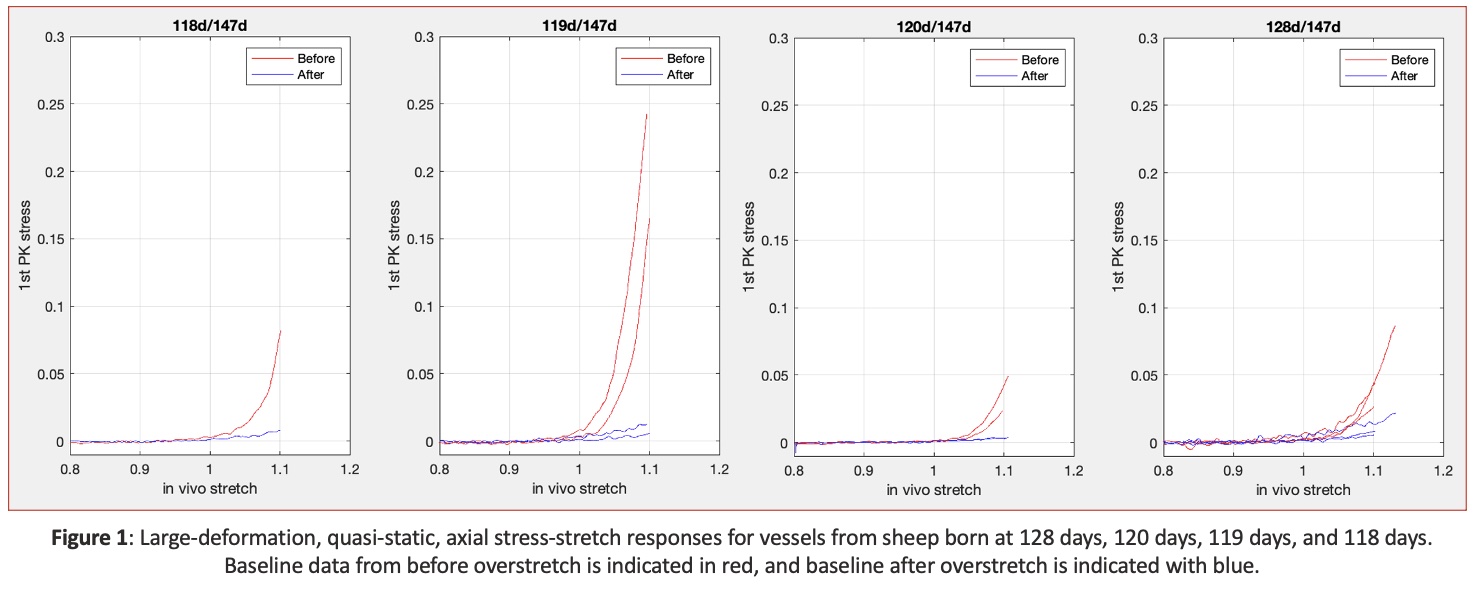The John and Marcia Price College of Engineering
12 Preliminary Mechanical Study of Preterm Middle Cerebral Arteries
Kerrigan Denham and Ken Monson
Faculty Mentor: Ken Monson (Mechanical Engineering, University of Utah)
Introduction
In 2020, 13.4 million infants were born premature [1]. Of infants born before 32 weeks and weighing less than 1.5 kg, 32% will experience interventricular hemorrhage (IVH), which is bleeding in the ventricle region of the brain. Of these cases, 75% will experience long term neurological disabilities. It is suspected that structural deficiencies in developing cerebral vasculature plays a significant role in the occurrence of IVH [2]. The goal of this preliminary study was to compare the development of mechanical damage in middle cerebral arteries (MCAs) of different gestational age groups.
Methods
Tissue Collection and Preparation: Preterm lamb MCAs were collected from the Albertine Lab in the Department of Pediatric Medicine at the University of Utah’s School of Medicine. All samples were classified as moderately preterm cases (80 to 92.5% gestation), as seen in Table 1. MCA branches were then ligated and cut into test segments around 6 mm in length.

Mechanical Testing: After the tissue was prepared, the test segments went through the mechanical testing procedure previously reported by the Monson Lab [3]. In brief, MCA test segments were mounted to cannula and preconditioned by cycling the pressure from 6.7 to 20 kPa. The in vivo length was determined using the load and pressure values found during preconditioning. Before the vessel was subjected to damage via a quasi-static axial overstretch of 1.3 times the in vivo length, sample properties were determined through a baseline stretch of 1.1 the in vivo length. After overstretch, the vessel was re-characterized using the same baseline procedure.
Results/Discussion
Figure 1 depicts the stress-stretch response for every sample in the study before and after overstretch. Samples from lower gestational ages (118 and 119 days) tended to have larger initial stress values when brought to a baseline stretch of 1.1 relative to the in vivo length. This could be an indication that the elastin and collagen fibers in these vessels are still developing significantly in lower gestational ages. Comparison of the stress-stretch response before and after overstretch shows that there is a significant reduction in vessel stiffness, indicating that the vessel microstructure has experienced damage, likely due to collagen and elastin fiber failure.

Conclusions
This preliminary research shows that are significant differences in mechanical responses for varying gestational ages. However, this study only included a range of samples from moderately preterm cases. Further research will be done to include other preterm classifications, including extremely preterm (less than 70% gestation) and very preterm (70 to 80% gestation). Further research will also be done to link mechanical damage to IVH, specifically how vessel microstructural damage causes leakage.
Bibliography
[1] ‘Preterm birth’, World Health Organization (2023)
[2] Nye, American Journal of Perinatology (2014)
[3] Nye, Annals of Biomedical Engineering (2016)

